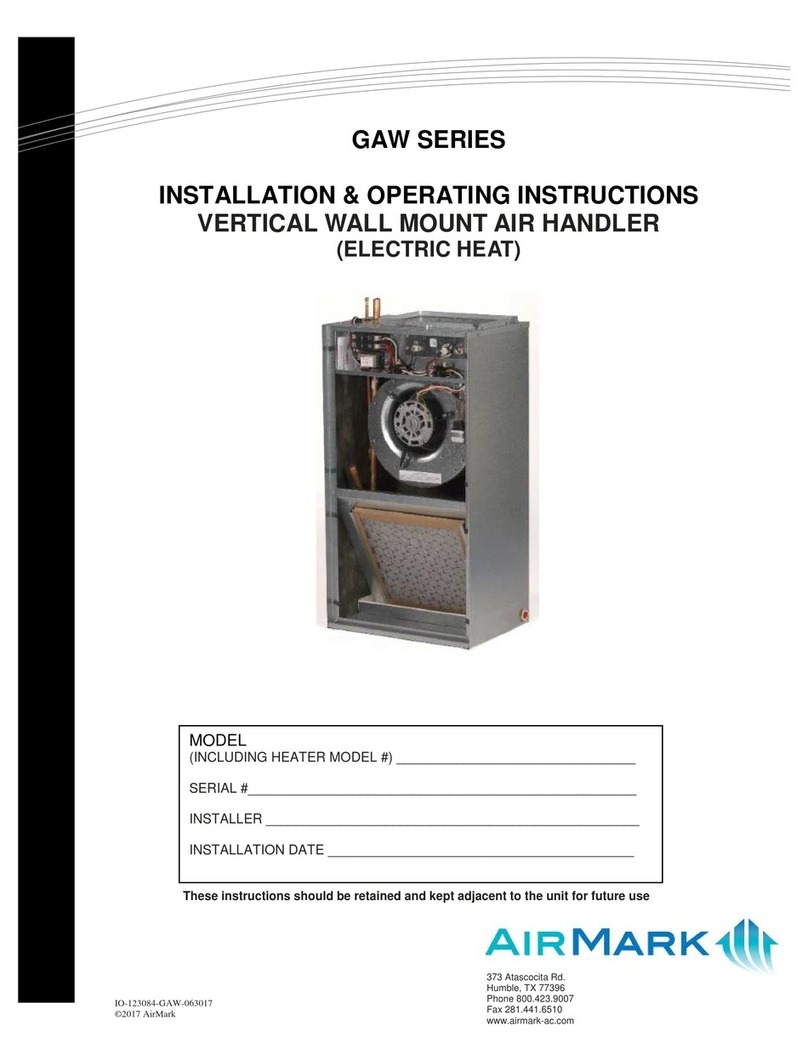IO-123078-GEW-081517 - 9 -
©2017 AirMark
OPERATION AND MAINTENANCE
Below are brief descriptions of the key
components of the unit and installation. This
manual only provides a general idea of the
components and recommended practices. The
installer should use best judgment to ensure safe
installation and operation of the unit.
1) Room Thermostat- This is the device that
controls that operation of your heating and/or
cooling unit. It senses the indoor temperature
and signals the equipment to start or stop
maintaining the temperature you have
selected for your comfort. The room
thermostat should be in a central, draft free
inside wall location for best operation. Do not
place any heat producing apparatus such as
lights, radio, etc., near the thermostat as this
will cause erratic operation of the comfort
system. The thermostat can accumulate dust
or lint which can affect its accuracy. It should
be cleaned annually.
2) Air Filter(s) - All central air moving comfort
systems must include air filter(s). These filters
will be located either in the equipment or in the
return air duct system upstream of the
equipment. The filter(s) removes dust and
debris from the air thus helping to keep your
air-conditioned space clean. More important,
the filter keeps dust and debris from collecting
on the heat transfer surfaces thus maintaining
optimum equipment efficiency and
performance. Inspect and clean or replace
filters every month. This routine maintenance
procedure will pay big dividends in reduced
operating cost and reduced service expense.
Never operate comfort equipment without
filter(s).
3) Fuses and/or Circuit Breakers- This comfort
equipment should be connected to the building
electric service in accordance with local and
National Electric codes. This electrical
connection will include over-current protection
in the form of circuit breakers. Have your
contractor identify the circuits and the location
of over-current protection so that you will be in
a position to make inspections or
replacements in the event the equipment fails
to operate.
4)
WARNING
a) Do not store combustible materials or use
gasoline or other flammable liquids or
vapors in the vicinity of this appliance.
b) Do not operate the comfort equipment with
panels removed.
c) Have your contractor point out and identify
the various cut-off devices, switches, etc.,
that serve your comfort equipment. There
is a main switch that will cut off energy to
your heating system. Know where they are
so that you may cut off the flow of energy
in the event of overheating.
5) Periodic Checkup and Service- This product is
designed to provide many years of
dependable, trouble-free comfort when
properly maintained. Proper maintenance will
consist of annual check-ups and cleaning of
the internal electrical and heat transfer
components by a qualified service technician.
Failure to provide periodic checkup and
cleaning can result in excessive operating cost
and/or equipment malfunction.
6) Lubrication- Direct drive blower motors are
equipped with permanently lubricated bearings
and do not require further lubrication.
7) Air filter replacement: An air filter can restrict
the airflow to the fan coil if it is not cleaned or
replaced periodically. When replacing the air
filter, always replace with the same type and
size as originally furnished with the unit.





























